What are the guidelines to selecting large cichlids as tank mates? Assuming the tank is large enough, do people mix species like red terrors, Mayans, dovii, or cichla? All of those species are so fascinating to me it seems like it would be hard to pick just one for a monster tank. How does that work? Thanks in advance!!
Aggressive cichlids as tank mates?
- Thread starter DocBrock
- Start date
You are using an out of date browser. It may not display this or other websites correctly.
You should upgrade or use an alternative browser.
You should upgrade or use an alternative browser.
Welcome to the forum!
Realistically, the only way to successfully mix large and aggressive cichlids is an incredibly large tank. They don’t mix well at all.
All of those big mean cichlids won’t like company or anything that looks like them, so mixing fish that are all different will help.
To properly keep them as they would naturally exist and to minimize aggression, it’s best to keep to solo or pairs as the only cichlids in the tank.
Realistically, the only way to successfully mix large and aggressive cichlids is an incredibly large tank. They don’t mix well at all.
All of those big mean cichlids won’t like company or anything that looks like them, so mixing fish that are all different will help.
To properly keep them as they would naturally exist and to minimize aggression, it’s best to keep to solo or pairs as the only cichlids in the tank.
Welcome to the forum!
Realistically, the only way to successfully mix large and aggressive cichlids is an incredibly large tank. They don’t mix well at all.
All of those big mean cichlids won’t like company or anything that looks like them, so mixing fish that are all different will help.
To properly keep them as they would naturally exist and to minimize aggression, it’s best to keep to solo or pairs as the only cichlids in the tank.
Thank you! So realistically I'd have to pick a pair of one kind? I lived in Florida for a while and the canals were infested with Mayans from fry to some very large adults and they're one of the hardest biting, hardest fighting fish id ever seen. I can only imagine how they would be in an aquarium. But they are so beautiful.
Actually, finding and buying "a pair" is not often done, unless you are very lucky. Typically, you buy a small group of youngsters, let them grow up and select their own partners and then re-home the others.
I'm not a rabid cichlid fan but have kept and bred many different species over the years. I'd say that the absolute number one requirement for keeping a cichlid community that isn't a stressed-out bloodbath is...a couple of spare aquariums to house injured fish, or bad actors, or others that just don't fit in. Cichlids are, IMHO, "fishroom fish"...they're not fish for the one-tank keeper.
I'm not a rabid cichlid fan but have kept and bred many different species over the years. I'd say that the absolute number one requirement for keeping a cichlid community that isn't a stressed-out bloodbath is...a couple of spare aquariums to house injured fish, or bad actors, or others that just don't fit in. Cichlids are, IMHO, "fishroom fish"...they're not fish for the one-tank keeper.
Actually, finding and buying "a pair" is not often done, unless you are very lucky. Typically, you buy a small group of youngsters, let them grow up and select their own partners and then re-home the others.
I'm not a rabid cichlid fan but have kept and bred many different species over the years. I'd say that the absolute number one requirement for keeping a cichlid community that isn't a stressed-out bloodbath is...a couple of spare aquariums to house injured fish, or bad actors, or others that just don't fit in. Cichlids are, IMHO, "fishroom fish"...they're not fish for the one-tank keeper.
I never thought of it like that. I appreciate the insight
This is a huge subject and there is no simple equation.
 jjohnwm
has a good point. Spare aquariums can be a godsend. Especially for what you are looking at. Pairing and matching cichlids that are aggressive or mildly aggressive can be very tricky.
jjohnwm
has a good point. Spare aquariums can be a godsend. Especially for what you are looking at. Pairing and matching cichlids that are aggressive or mildly aggressive can be very tricky.
Also agree with getting juveniles and re-homing argument. I cannot disagree with that at all as that is exactly how I have delt with my cichlids. I don't have room for spare tanks.
Also agree with getting juveniles and re-homing argument. I cannot disagree with that at all as that is exactly how I have delt with my cichlids. I don't have room for spare tanks.
I never thought of it like that. I appreciate the insight
Lol, you're welcome, but I only wish it were "insight". After making every mistake possible over a few decades, it is...unfortunately...hindsight.
If you look at nature, you hardly ever find 2 cichlids of the same genus together, or two of the same feeding types. An d there are reasons for this, primary among them is 2 of the same genus, or 2 piscivores would be competing for the same resources. (there are some exceptions such as 2 shoaling species like Thorichthys) but this type are not what you are asking about, and these are social.
West of the Andes where Mesoheros festae are found they are basically the only cichlid of their iik, the other a Geophagus sand sifter.
Where N haitiensus are found, they are the only cichlid of its kind, there may have been more a million years ago, but it is theorized the less robust and equipped cichlid to adapt was made extinct by haitiensus
Where you do find communities of new world species, they often have different feeding strategies, that limit competition for resources.
For example in Lake Bacalar you find Vieja (omnivore with vegetarian tendencies) Thorichthys meeki (a sand sifter), Crytoheros spilurus (insectivore) Mayaheros uropthalmus (generized omnivore), and Trichromis salvini (predator).
If you tank is in the 1000 gal range you may get away with a couple, but small tanks in 100 to 200 range are seldom viable
Where I live and collect cichlids, in the Mamoni river, I have yet to find more that 3 species.
Darienheros calobrensis, a substrate picker that prefers rheophillic areas
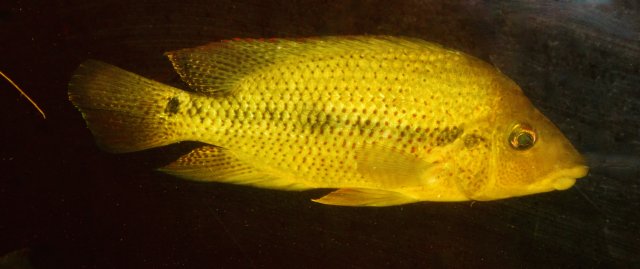
Ithmoheros tuyrensus, an omnivore with vegetarian tendencies (similar to Vieja)
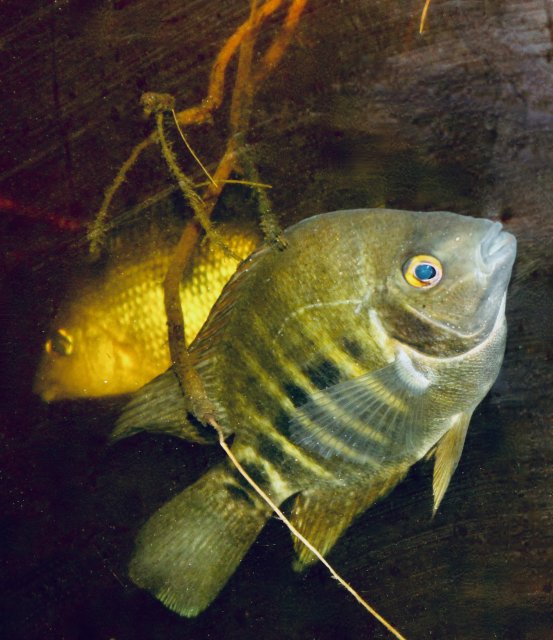
And Andinoacara coerleopunctatus, a generalize predator/omnivore that prefer more slack water areas.
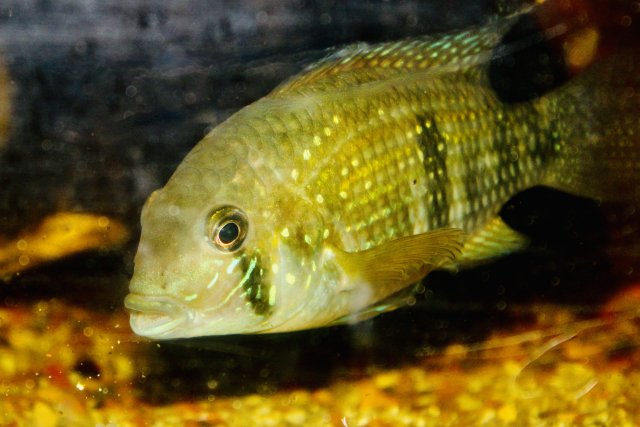
notice how mouth shapes differ, which may help indicate to other cichlids of their trophic preference and non-competitive nature.
None also get that large, and I have kept them together, as a Mamoni river biotope, but adding another more aggressive cichlid than just he 3, would appear to me to be a mistake.
I did add a predatory Mamoni goby that at first ate all Mamoni tetras (dithers), grew some and then ate or killed Mamoni Plecos, grew some more, then started to selectively kill cichlids
I will not do that again.
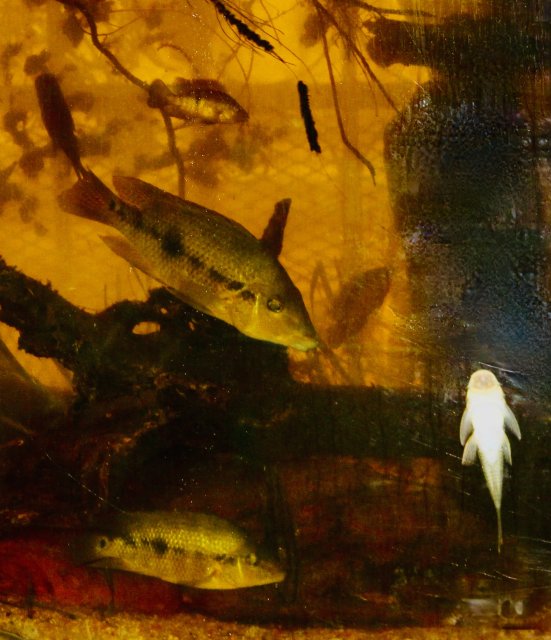
Above the attempted community.
What I find best, are only single, or 2 species only tanks for Central American, and west of the Andes cichlids , and then only if they are very carefully selected.
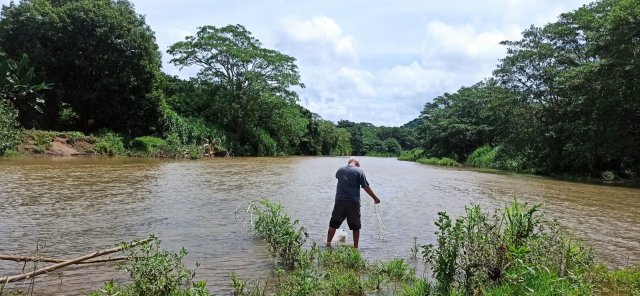
West of the Andes where Mesoheros festae are found they are basically the only cichlid of their iik, the other a Geophagus sand sifter.
Where N haitiensus are found, they are the only cichlid of its kind, there may have been more a million years ago, but it is theorized the less robust and equipped cichlid to adapt was made extinct by haitiensus
Where you do find communities of new world species, they often have different feeding strategies, that limit competition for resources.
For example in Lake Bacalar you find Vieja (omnivore with vegetarian tendencies) Thorichthys meeki (a sand sifter), Crytoheros spilurus (insectivore) Mayaheros uropthalmus (generized omnivore), and Trichromis salvini (predator).
If you tank is in the 1000 gal range you may get away with a couple, but small tanks in 100 to 200 range are seldom viable
Where I live and collect cichlids, in the Mamoni river, I have yet to find more that 3 species.
Darienheros calobrensis, a substrate picker that prefers rheophillic areas

Ithmoheros tuyrensus, an omnivore with vegetarian tendencies (similar to Vieja)

And Andinoacara coerleopunctatus, a generalize predator/omnivore that prefer more slack water areas.

notice how mouth shapes differ, which may help indicate to other cichlids of their trophic preference and non-competitive nature.
None also get that large, and I have kept them together, as a Mamoni river biotope, but adding another more aggressive cichlid than just he 3, would appear to me to be a mistake.
I did add a predatory Mamoni goby that at first ate all Mamoni tetras (dithers), grew some and then ate or killed Mamoni Plecos, grew some more, then started to selectively kill cichlids
I will not do that again.

Above the attempted community.
What I find best, are only single, or 2 species only tanks for Central American, and west of the Andes cichlids , and then only if they are very carefully selected.

Last edited:
In contrast to Central America, South America seems to have many more communal cichlid groupings, and population densities, and maybe because of these factors, the temperament is much more relaxed in S American tanks, if planned right .
The size of the South American continent alone, and its available space compared to the postage stamp swath of land and ithe watersheds, in Central America may contribute to the reason.
Or even the useable climatic cichlid strip of land west of the Andes, and its limited space compared to Amazonia and the rest of South America, may contribute to the lack cichlid population diversity there.
But even in the S American communities, the trophic needs, water velocity needs, and compatible shape differences are obvious as to what is found together.
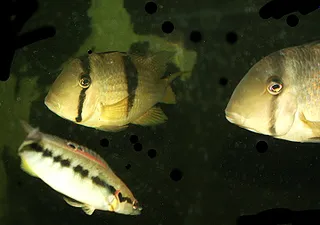
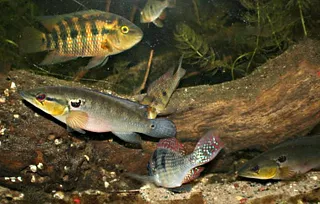
For instance, I would not keep rheophillic species like Retroculus, or some of the current loving Geophagines, with cichlids that prefer a much more low flow environment like environment, such as the Heros genus, discus or angels.
Or the winter cool down needing, temperate cichlids of Uruguay, or others from the southern part of the continent, , with the tropical species of northern S America.
The size of the South American continent alone, and its available space compared to the postage stamp swath of land and ithe watersheds, in Central America may contribute to the reason.
Or even the useable climatic cichlid strip of land west of the Andes, and its limited space compared to Amazonia and the rest of South America, may contribute to the lack cichlid population diversity there.
But even in the S American communities, the trophic needs, water velocity needs, and compatible shape differences are obvious as to what is found together.


For instance, I would not keep rheophillic species like Retroculus, or some of the current loving Geophagines, with cichlids that prefer a much more low flow environment like environment, such as the Heros genus, discus or angels.
Or the winter cool down needing, temperate cichlids of Uruguay, or others from the southern part of the continent, , with the tropical species of northern S America.
Nice one I think some great points there. It does seem (and I'm absolutely guilty of this) that when people get into the hobby they want lots of different cichlids chucked together to achieve "diversity", when in nature its nothing like that. Well not only cichlids but any kind for that matter.
As I said I've been guilty of that. I've only been in the hobby a couple years but can already see, less is more. I just have to slowly move in that direction. For example, sorry but off topic, one of my most pleasing tanks now is a 75G with only rummy nose tetras. i.e. a species only tank.
For Cichlids I have a 10ft CA tank but even then I can see me continuing to reduce the species till there is only 1 or 2 in the end. That way you may be able to keep aggressive species with less chance of a blood bath....or not they are cichlids. For the 10ft tank I would like to make it a Red devil tank. I have 3 in it now growing out and I'm sure over time they will be the dominant ones in the tank so will reduce over time as it needs to be so will probably be a natural selection to reduce species.
As I said I've been guilty of that. I've only been in the hobby a couple years but can already see, less is more. I just have to slowly move in that direction. For example, sorry but off topic, one of my most pleasing tanks now is a 75G with only rummy nose tetras. i.e. a species only tank.
For Cichlids I have a 10ft CA tank but even then I can see me continuing to reduce the species till there is only 1 or 2 in the end. That way you may be able to keep aggressive species with less chance of a blood bath....or not they are cichlids. For the 10ft tank I would like to make it a Red devil tank. I have 3 in it now growing out and I'm sure over time they will be the dominant ones in the tank so will reduce over time as it needs to be so will probably be a natural selection to reduce species.


